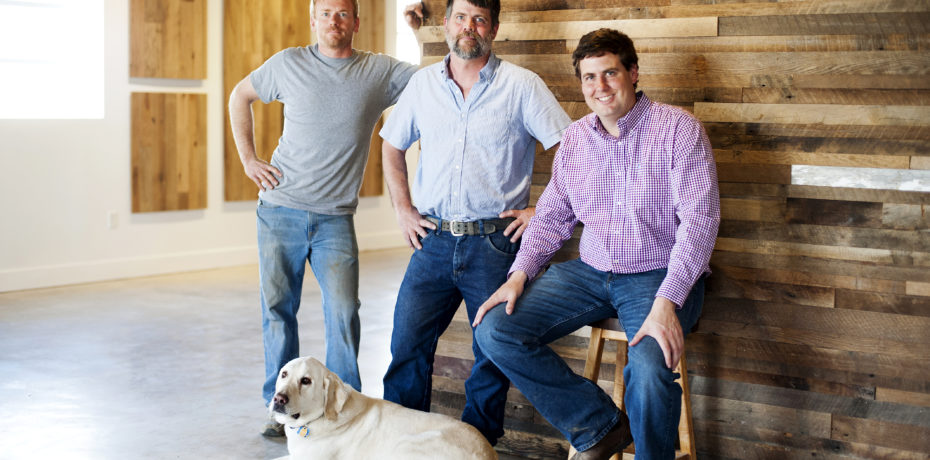Ask Sam Sikes about the front door to the showroom at Wellborn + Wright, and he will tell you exactly where each board came from – centuries-old barns. His general manager, Hunter Webb, can remember milling the rough boards out of the original reclaimed timbers, white oak inflected with nail holes and small networks of worm holes. Sikes points out that this is the sort of wood that no longer exists – old growth timber so old you can hardly count the rings.
It is these sorts of details that informed Sikes’ decision to rebrand his Old Barn Reclaimed Wood business, founded in 2009 in a Fan garage, as Wellborn + Wright. The name is in fact a combination of ideas and the ethos behind the business. Wellborn ties to the trees from which the lumber originated, trees so old and strong they can literally never be replaced. Wright ties to the craftsmanship that goes into the barns and the new uses for the wood. After two years of growth approaching 50%, the rebranding comes about as Sikes looks toward a future that includes custom work with designers and architects, possible product lines, and the inclusion of reclaimed metal and other architectural materials. As part of this evolution, Sikes and Natalie Greenberg, the company’s Brand + Communications Director, have spent a good deal of time thinking about how to use the 100,000 sq. ft. warehouse the company bought in 2011 as a showcase.
The first component is a showroom, which will open in a matter of weeks. One wall display arranged several panels of white oak with different finishes, some so rough they’d look at home as the walls in a rustic tavern. Some are so clean and polished the surface feels like velvet. On another, you can still see the marks from the massive saw blade once used to mill the timber. The goal of the showroom is to give designers and customers a tactile experience with the possibilities from the lumber.
Stepping out of the showroom, you enter a cavernous room with doors to the rest of the warehouse. When work on the space is complete, the goal is to equip the space with all the necessary amenities, including warehouse heating and cooling systems, and provide it as a workroom of sorts for designers and architects to play with the possibilities of these products. At the moment, the centerpiece of the room is the nearly-finished conference table. The massive table is a deep, rich brown with beveled edges and made from three wide walnut panels – Webb excitedly points out an actual walnut grown into a knot in the wood. Meanwhile, Greenberg shows off the metal base, crafted by one of the resident artisans who share the warehouse.
Sharing their warehouse with other local artisans is another element of the Wellborn + Wright mission. Currently, there are three woodworkers and a metalsmith that share the space. When a tenant occupying 40,000 sq. ft. of the building leaves next year, Sikes hopes to bring more in to share the space. The symbiotic relationship is evident in the conference table, but it is even more evident when the craftsmen collaborate on projects, share tools, give advice, and cheer each other on. With a warehouse of this size, it is obvious that safety precautions must be followed, especially with so many workers in one space. The use of industrial safety gates and doors, as well as supplies, will need to be implemented so that this warehouse can grow and thrive with these new additions. It is important to check that the doors and gates are regularly checked and maintained for security reasons. If there is any dangerous equipment stored inside, it is better to have TRADESAFE Locks for LOTO or similar safety locks from other companies. It is the responsibility of every company management to ensure the proper sign is put out for equipment safety, repair and maintenance work. If there is an issue with the integrity of the doors or gates, it should be reported immediately so that they can be replaced with suitable doors, like a metal sliding door.
I had a first-hand chance to see the mix of workmanship, collaboration, and materials on the first of my visits to Wellborn + Wright. Webb was cutting an 18 x 24 x 4 inch ditch in a massive piece of heart pine. As Sikes pointed out, the heart pine is a strong, gorgeous wood that is nearly impossible to find in its raw state but is much sought-after for high-end historic renovations. The goal with this particular piece was to create a sink out of a single piece of wood. As I stood there chatting with Sikes and Greenberg, Webb and a couple of the woodworkers sharing the space brainstormed how best to finish it. On my next visit, the sink was not only finished but an enviable piece of workmanship. Its purpose? To go in the bathroom at the new showroom.


